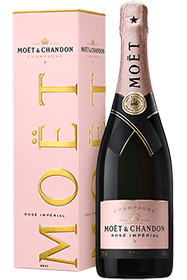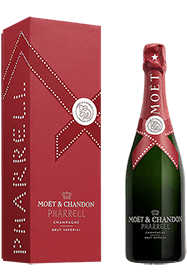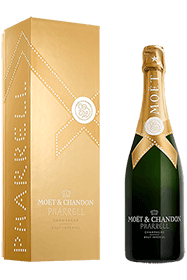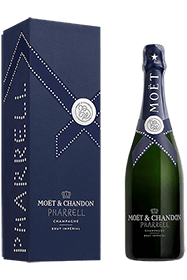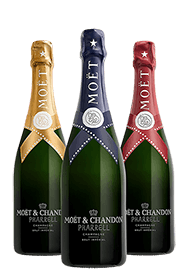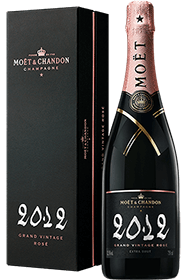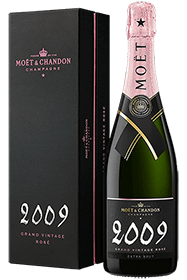Moët & Chandon owns the largest vineyard in the Champagne region. The majority of its terroirs are classified as crus, grands crus and premiers crus, allowing the production of very high quality wines. The name Moët & Chandon is known throughout the world : the House has anchored its reputation in France and internationally since its creation.
Moët & Chandon, the most famous property in Champagne
The Moët & Chandon Champagne House was founded in 1743 by Claude Moët, a visionary wine merchant, who quickly made its name among the European courts. A few years later his grandson, Jean-Rémy Moët, developed the House's international reputation.
Jean-Rémy Moët created the House's emblematic cuvée, Moët Imperial, in honour of the Emperor Napoleon Bonaparte, who visited the estate several times and is said to have invented with his troops the gesture of sabering bottles of Moët & Chandon champagne to celebrate a victory.
Several festive traditions were born thanks to the brand. The German emperor William II launched his yacht with Moët & Chandon Brut Impérial, starting the tradition. The pyramid of flutes and the rain of celebrationary champagne at car race victories is done with Moët et Chandon.
Owned by the LVMH group since 1987, the house develops unique cuvées from a meticulous selection of Champagne terroirs that are world renowned for their quality and enchanting character.
A diversity of exceptional terroirs and unique know-how
Thanks to the plots planted mainly on limestone soils and to a know-how that has been passed down for several centuries, Moët & Chandon produces champagne of the greatest quality.
75% of its terroir is classified
The estate owns more than 1150 hectares across the 5 vineyards of the Champagne appellation. This area, with its mosaic of terroirs, promotes the creation of exceptional wines. Most of the plots are classified as crus, grand crus and premier crus and are planted on limestone soil, bringing finesse and minerality to the wine. Depending on the harvest, certain Brut champagnes are created when they are of exceptional quality. Moët & Chandon preserves its terroirs and attaches great importance to the protection of the environment. Chemical products are avoided as much as possible in the vineyards.
A refined style achieved through its blend
Moët & Chandon has handed down the know-how acquired over the ages by respecting ancestral methods. However, the company has adopted the most modern techniques in order to maximise the potential of its terroir and its grapes. The company produces more Pinot Noir and Pinot Meunier than Chardonnay. These two red grape varieties make the majority in these champagnes, giving them a delicious, rounded and structured profile. Chardonnay is part of the blend but to a lesser extent : 20 to 30% is added to bring freshness and elegance. The style of Moët & Chandon champagnes is characterised by their generosity and finesse.
How many grams of sugar does a Moët et Chandon Brut champagne contain?
The Brut dosage is an addition of 6 to 12 grams of sugar per litre contained in the liqueur d'expédition, also called liqueur de dosage. It defines the style of the champagne. Today, 90% of champagnes are Brut. The cuvées are dosed at 7 grams of sugar per litre, allowing a crystalline and elegant profile to be defined, leaving the scents to develop fully.
Moët et Chandon's brut champagne collection
The House keeps the same profile for its brut champagnes, whether they are white or rosé, with a preference for red grape varieties in the blends. However, the Grands Vintages do not all follow this model. For large formats, Moët et Chandon magnums and jeroboams are available for certain cuvées.
Moët et Chandon Brut Impérial: an emblematic Brut Sans Année
A BSA or Brut Sans Année, is the signature cuvée of each champagne brand. All the houses create their own identity through the style of their BSA, making it a real stamp. At Moët et Chandon, the production of Pinot Noir and Pinot Meunier carries more weight than that of Chardonnay. This proportion is reflected in the blend of their BSA, the Brut Impérial. Grapes from an excellent terroir of over 200 crus are used to make this champagne. In order to give it a unique character, 20-30% reserve wines are added, which increases its complexity.
The iconic party champagne
Moët et Chandon Brut Impérial, created in 1869, is known across the globe and has become a cultural reference. In 1893, Moët et Chandon became the official supplier to Queen Victoria. After that, Brut Impérial was quickly adopted by high society and Hollywood celebrities, becoming a symbol of the French style of elegant entertaining. Celebrities such as Cary Grant, Kim Novak, Andy Warhol, Catherine Deneuve and Monica Bellucci have been photographed drinking Moët et Chandon Brut Impérial. Everyone knows the famous bottle with its gold and black foil and red seal. It features in the James Bond film Dr. No (1962) and more recently in The Great Gatsby (2013).
The Brut Impérial Rosé
This Moët & Chandon rosé champagne has the same characteristics as the classic cuvées with a higher proportion of Pinot Noir and Pinot Meunier as in the Brut Impérial. It is intensely fruity with notes of strawberries, raspberries and redcurrants and a liveliness underlined by fresh menthol scents.
Grands Vintages: exceptional vintage brut champagnes
Outstanding years deserve special attention, which is why Moët et Chandon has created its Grands Vintages label. They are white or rosé and are brut or extra brut. These exemplary vintages are 1998, 1980, 1976, 1961, 1955 and 1949. The Grands Vintages are unique and made exclusively with wines of the year ; no reserve wine is added. The blending is carried out by Benoît Gouez, Moët et Chandon's cellar master. The 2013 vintage has a striking maturity. The proportions of grape varieties differ from the usual style of Moët et Chandon, being made mostly with chardonnay, which gives it pear and white flower scents and a refreshing vivacity.
Champagne cocktails
Mixology is the thing right now, and many alcohol producers create their own cocktails. Those made with champagne originate from the 19th century. Moët et Chandon revisits the most famous ones.
The champagne cocktail
This legendary cocktail was created in 1855 in Panama. Moët et Chandon Brut Impérial is the main ingredient, enhanced with sugar syrup and Caribbean angostura bitters. Served in an ice-filled glass, it is often garnished with a lemon peel.
L'Impérial 1869
Moët et Chandon’s cocktail refers to the year the famous cuvée was created. This cocktail enhances the Brut Impérial champagne by integrating orange blossom water and grapefruit bitter to bring out its floral notes. Agave syrup is added to bring roundness. Impérial 1869 is served in a champagne glass.
